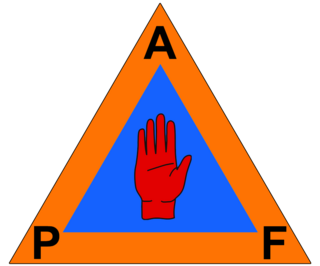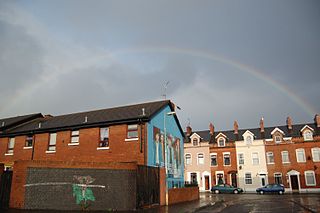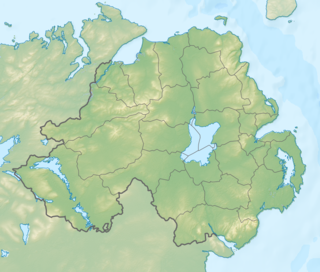Related Research Articles

The Irish People's Liberation Organisation was a small Irish republican paramilitary organisation which was formed in 1986 by disaffected and expelled members of the Irish National Liberation Army (INLA) whose factions coalesced in the aftermath of the supergrass trials. It developed a reputation for intra-republican and sectarian violence and criminality, before being forcibly disbanded by the Provisional Irish Republican Army (IRA) in 1992.

The Orange Volunteers (OV) or Orange Volunteer Force (OVF) is a small Ulster loyalist paramilitary group in Northern Ireland. It was formed in 1998 by loyalists who opposed the Belfast Agreement and the loyalist ceasefires. Over the following year it carried out a wave of bomb and gun attacks on Catholics and Catholic-owned properties in rural areas, but since 2000 has been relatively inactive. The group has been associated with elements of the Orange Order and has a Protestant fundamentalist ideology. OV’s original leader was Clifford Peeples. The OV are a Proscribed Organisation in the United Kingdom under the Terrorism Act 2000 and have been included on the U.S. State Department’s, “Terrorist Exclusion List”, since 2001.
This is a chronology of activities by the Provisional Irish Republican Army (IRA) from 1970 to 1979. For actions after this period see Chronology of Provisional Irish Republican Army actions.
The Troubles in Templepatrick recounts incidents during, and the effects of, The Troubles in Templepatrick, County Antrim, Northern Ireland.
The Troubles in Cookstown recounts incidents during, and the effects of, The Troubles in Cookstown, County Tyrone, Northern Ireland.
The Troubles in Lisburn recounts incidents during, and the effects of, the Troubles in Lisburn, County Antrim, Northern Ireland.
The Troubles in Keady refers to incidents taking place in Keady, County Armagh, Northern Ireland during the Troubles.
The South Armagh Republican Action Force sometimes called simply the Republican Action Force was an Irish republican paramilitary group that was active from September 1975 to April 1977 during the Troubles in Northern Ireland. Its area of activity was mainly the southern part of County Armagh. According to writers such as Ed Moloney and Richard English, it was a cover name used by some members of the Provisional IRA South Armagh Brigade. The journalist Jack Holland, alleged that members of the Irish National Liberation Army (INLA) were also involved in the group. During the same time that the South Armagh Republican Action Force was active the INLA carried out at least one sectarian attack that killed Protestant civilians using the covername "Armagh People's Republican Army". According to Malcolm Sutton's database at CAIN, the South Armagh Republican Action Force was responsible for 24 deaths during the conflict, all of whom were classified as civilians.

The name Protestant Action Force (PAF) was used by loyalists, especially members of the Ulster Volunteer Force (UVF), to claim responsibility for a number of paramilitary attacks during the Troubles. It was first used in this context in 1974, and has since been used to claim the killings of at least 41 Catholic civilians.
This is a timeline of actions by the Ulster Defence Association (UDA), a loyalist paramilitary group formed in 1971. Most of these actions took place during the conflict known as "the Troubles" in Northern Ireland. The UDA's declared goal was to defend Loyalist areas from attack and to combat Irish republican paramilitaries. However, most of its victims were Irish Catholic civilians, who were often chosen at random.
This is a timeline of actions by the Ulster Volunteer Force (UVF), an Ulster loyalist paramilitary group since 1966. It includes actions carried out by the Red Hand Commando (RHC), a group integrated into the UVF shortly after their formation in 1972. It also includes attacks claimed by the Protestant Action Force (PAF), a covername used by the UVF. Most of these actions took place during the conflict known as "the Troubles" in Northern Ireland.
The Chlorane Bar attack was a mass shooting at a city centre pub on 5 June 1976 in Belfast, Northern Ireland. It was carried out by the Ulster Volunteer Force (UVF), an Ulster loyalist paramilitary organisation, apparently in retaliation for the Provisional IRA bombing attack on the Times Bar on York Road, in which two Protestant civilians were killed. In the Chlorane attack, five men were killed; three Catholics and two Protestants. The gunmen were from the UVF Belfast Brigade's Shankill Road battalion. The assault was a joint operation by the platoons based at the Brown Bear and the Windsor Bar, drinking haunts in the Shankill Road district frequented by UVF members.

The Shore Road is a major arterial route and area of housing and commerce that runs through north Belfast and Newtownabbey in Northern Ireland. It forms part of the A2 road, a traffic route which links Belfast to the County Antrim coast.
The Antrim Road is a major arterial route and area of housing and commerce that runs from inner city north Belfast to Dunadry, passing through Newtownabbey and Templepatrick. It forms part of the A6 road, a traffic route which links Belfast to Derry. It passes through the New Lodge, Newington and Glengormley areas of Northern Ireland amongst others.

The Ramble Inn attack was a mass shooting at a rural pub on 2 July 1976 near Antrim, Northern Ireland. It is believed to have been carried out by the Ulster Volunteer Force (UVF), a loyalist paramilitary organisation. Six civilians were killed in the attack—five Protestants and one Catholic—and three others were wounded.

On 14 November 1992, the Ulster Defence Association using the cover name the Ulster Freedom Fighters (UFF) launched a gun and grenade attack on James Murray's bookmakers on the Oldpark Road in Belfast, Northern Ireland. One gunman opened fire on the customers, whilst another threw a grenade into the shop. The shop was in an Irish nationalist area and all of the dead were local Catholic civilians.
On 2 October 1975, the loyalist paramilitary group the Ulster Volunteer Force (UVF) carried out a wave of shootings and bombings across Northern Ireland. Six of the attacks left 12 people dead and around 45 people injured. There was also an attack in a small village in County Down called Killyleagh. There were five attacks in and around Belfast which left people dead. A bomb which exploded in Coleraine left four UVF members dead. There were also several other smaller bombs planted around Northern Ireland but other than causing damage they didn't kill or injure anyone.

In the late hours of 3 February and the early hours of 4 February 1973, six men, all of whom were Catholics, were shot and killed in the New Lodge area of north Belfast:

The 1991 Craigavon killings took place on 14 November 1991 when the Mid-Ulster Brigade of the Ulster Volunteer Force (UVF) shot dead three civilians at the Carbet Road-Carn Road junction near Craigavon, County Armagh, Northern Ireland, on their way home from work at the Hyster forklift factory just outside Lurgan.

The Store Bar shooting was a mass shooting that occurred on the 25 June 1976 in the late evening when an armed group of men calling themselves the Republican Action Force walked into The Store Bar on Lyle Hill Road in Templepatrick, County Antrim.
References
- NI Conflict Archive on the Internet
- McKittrick, D, Kelters, S, Feeney, B and Thornton, C. Lost Lives. Mainstream Publishing, Edinburgh, 1999, p211 (Orrs) and p659, 660 and 662 (Ramble Inn)